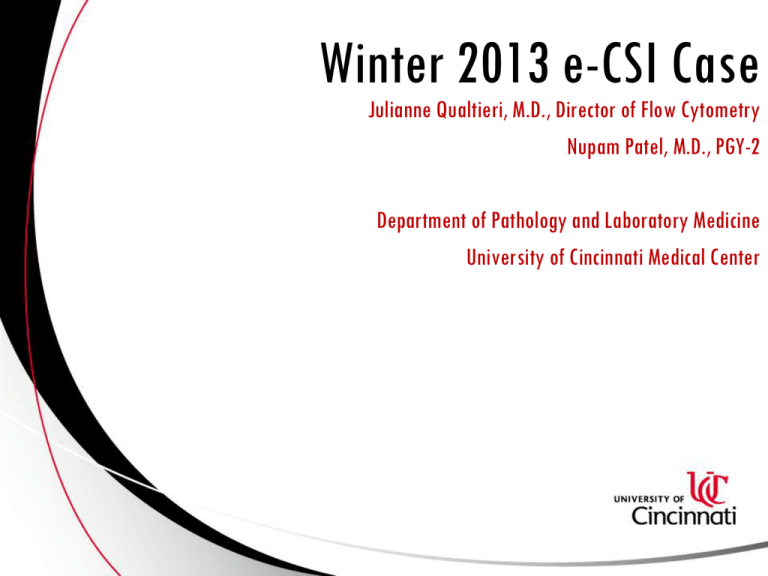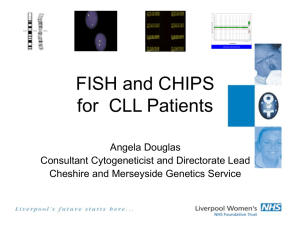eCSI case discussion - International Clinical Cytometry Society
advertisement

Winter 2013 e-CSI Case Julianne Qualtieri, M.D., Director of Flow Cytometry Nupam Patel, M.D., PGY-2 Department of Pathology and Laboratory Medicine University of Cincinnati Medical Center Clinical Presentation • A 67 year old man presents with fatigue and shortness of breath to the VA and is referred to our ER due to concern for acute leukemia. • Physical Examination shows massive splenomegaly • Past Medical History – Chronic lymphocytic leukemia (CLL) diagnosed 3.5 years ago by peripheral smear morphology – Last chemotherapy (no rituximab) four months ago – Reportedly, WBC count last month was 5 K/uL Laboratory Values Parameter Value Units Reference Range WBC 334.3 x109/L (3.8 - 10.8) RBC 1.89 x1012/L (4.20 - 5.80) HGB 6.1 g/dl (13.2 - 17.1) HCT 17.9 % (38.5 - 50.0) MCV 94.7 fl (80.0 - 100.0) MCH 32.4 pg (27.0 - 33.0) MCHC 34.2 gm/dl (32.0 - 36.0) RDW 15.4 % (11.0 - 15.0) PLT 43 x109/L (140 – 400) Laboratory Values CBC Differential Percentage Reference Range (%) Neutrophils 1% (40.0 - 80.0) Lymphocytes 1% (15.0 - 45.0) Monocytes 1% (0.0 - 12.0) Others 97% (0-0) Flow Cytometric Analysis • • • • • Tube 1: CD19 FITC / CD5 PE / CD45 ECD / CD20 PC5 Tube 2: CD19 FITC / CD34 PE / CD10 ECD / CD45 PC5 Tube 3: CD23 FITC / CD38 PE / CD19 ECD / CD45 PC5 Tube 4: CD79b FITC / CD43 PE / CD19 ECD / CD45 PC5 Tube 5: kappa FITC / lamba PE / CD19 ECD / CD45 PC5 Gating Strategy • The specimen is essentially composed of all lymphocytes. • Within the lymphocyte population, a large spectrum of size is seen (arbitrarily separated into smaller and large cells). Tube 1 • Smaller lymphocytes express CD20+ of moderate intensity, and large cells show brighter intensity. • CD5 is essentially negative Tube 2 • Lymphocytes are negative for CD10. • CD19 expression is brighter on larger cells. Tube 3 • Lymphocytes are negative for CD38. • Lymphocytes show dim partial expression of CD23. Tube 4 • Lymphocytes show dim CD79b with larger cells displaying brighter intensity. • Lymphocytes are essentially negative for CD43. Tube 5 • Lymphocytes show surface kappa light chain restriction. • Light chain expression is of moderate intensity, with large cells showing brighter intensity. Peripheral Blood Smear Cytogenetics • Conventional karyotype (of marrow): complex 45-47,Y,-X[3] ,?add(X)(q22), der(1)del(1)(p36.1) add(1)(q31),-2,-8,-9,add(11)(p11.2),add(12)(p13), der(12)add(12)(p11.2) add(12)(q24.1),add(13)(q22), del(13)(q13q22),-15[4],add(16)(p13.1),add(17)(q25), del(17)(p11.2),+mar1-6[cp20] • CLL FISH Panel – Loss of 13q14.3 in 100 % of nuclei – Loss of p53 in 100 % of nuclei Differential Diagnosis • B cell prolymphocytic leukemia (B-PLL): de novo versus transformation of a small B cell lymphoma • CLL with increased prolymphocytes Prolymphocytic Leukemia Definition – Neoplastic proliferation of prolymphocytes which comprise greater than 55% of lymphoid cells. – Subdivided into B-PLL and T-PLL, two distinctly different diseases. B-Cell Prolymphocytic Leukemia Epidemiology – Rare: Comprises approximately 1% of lymphocytic leukemias. • Increasingly rare since diagnosis excludes cases of atypical CLL, CLL with increased prolymphocytes, and lymphoid proliferation with t(11;14)(q13;q32). – Median Age: 65-69 years old with equal male:female distribution. B-Cell Prolymphocytic Leukemia Clinical Features – – – – – Systemic B symptoms (fevers, night sweats, and weight loss) Rapidly rising white blood cell count (typically >100,000/µL) Massive splenomegaly Anemia and thrombocytopenia may be present Lymphadenopathy is uncommon Origin of B-cell Prolymphocytic Leukemia • De novo (common) • Prolymphocytic transformation of CLL (rare) • Prolymphocytic transformation of SMZL (rarest) Classic Immunophenotype of B-PLL • • • • • Strong CD19+ Strong CD20+ Strong CD79b+ Strong CD22+ Strong Surface Ig • • • • • Strong FMC-7+ CD5 - (70-80% of cases) CD23 - (80-90% of cases) ZAP-70 +/-CD38 +/-- Prolymphocytic Transformation of CLL • Immunophenotypic changes • Decreased CD5 expression • Increased pan-B cell marker (e.g. CD20) and surface Ig intensity • Acquisition of FMC-7 • Some cases may retain same immunophenotype as CLL • Review of previous material, when available, is extremely helpful to verify the CLL component Prolymphocytic Transformation of Splenic B cell Lymphomas • Recently described entity [Hoehn] • Case series describes 3 splenic marginal zone lymphomas (SMZL) and one splenic diffuse red pulp small B cell lymphoma • All showed strong p53 expression by immunohistochemistry • Morphologic clues – Cytoplasmic projections – Bone marrow involvement typical of SMZL – Del(7q) in SMZL cases CLL with Increased Prolymphocytes • Prolymphocytes range from 10-54% in peripheral blood • Both p53 deletion/mutations and C-MYC translocations have been correlated with increased prolymphocytes in CLL [Bacher, Huh]. • Associated with more aggressive disease • Distinction between B-PLL – Currently morphology-driven – Gene expression profiling works but is not routinely available [Del Giudice] Our Final Diagnosis • • • • “Atypical B cell lymphoma with increased prolymphocytes” Favor an atypical CLL with increased prolymphocytes By morphology, prolymphocytes ~25% Case discussed at interdepartmental heme-onc conference – Marked change in tempo of disease requires aggressive treatment, as if a true prolymphocytic transformation – p53 deletion also necessitates aggressive treatment Treatment Strategy for Lymphoid Malignancies with p53 Abnormalities • Resistant to conventional chemotherapy (purine analogs). • Use of anti-CD20 monoclonal antibodies have shown some improvement. • Deletions or mutations of p53 have shown good response to treatment with alemtuzumab [Deardon]. • Hematopoietic stem cell transplant should be considered for suitable candidates. References • • • • • • • Bacher, U., W. Kern, C. Schoch, W. Hiddemann, and T. Haferlach. "Discrimination of Chronic Lymphocytic Leukemia (CLL) and CLL/PL by Cytomorphology Can Clearly Be Correlated to Specific Genetic Markers as Investigated by Interphase Fluorescence in Situ Hybridization (FISH)." Annals of Hematology . 83.6 (2004): 349-55. Dearden, Claire. "B- and T-cell Prolymphocytic Leukemia: Antibody Approaches." American Society of Hemotology Education Book .1 (2012): 645-51. Dearden, Claire. "How I Treat Prolymphocytic Leukemia." Blood .120 (2012): 538-51. Del Giudice, I., N. Osuji, T. Dexter, V. Brito-Babapulle, N. Parry-Jones, S. Chiaretti, M. Messina, G. Morgan, D. Catovsky, and E. Matutes. "B-cell Prolymphocytic Leukemia and Chronic Lymphocytic Leukemia Have Distinctive Gene Expression Signatures." Leukemia . (2009): 2160-2167. Hoehn D, Miranda RN, Kanagal-Shamanna R, Lin P, Medeiros LJ. Splenic B-cell lymphomas with more than 55% prolymphocytes in blood: evidence for prolymphocytoid transformation. Hum Pathol. 2012 Nov;43(11):182838. Huh, Yang O., Katherine I-Chun Lin, Francisco Vega, Ellen Schlette, C. Cameron Yin, Michael J. Keating, R. Luthra, L. Jeffrey Medeiros, and Lynne V. Abruzzo. "MYC Translocation in Chronic Lymphocytic Leukaemia Is Associated with Increased Prolymphocytes and a Poor Prognosis." British Journal of Haematology . 142.1 (2008): 36-44. Lens, Daniela, J.J.C. De Schouwer, Rifat A. Hamoudi, and et al. "P53 Abnormalities in B-Cell Prolymphocytic Leukemia." Blood . 89 (1997): 2015-023.






